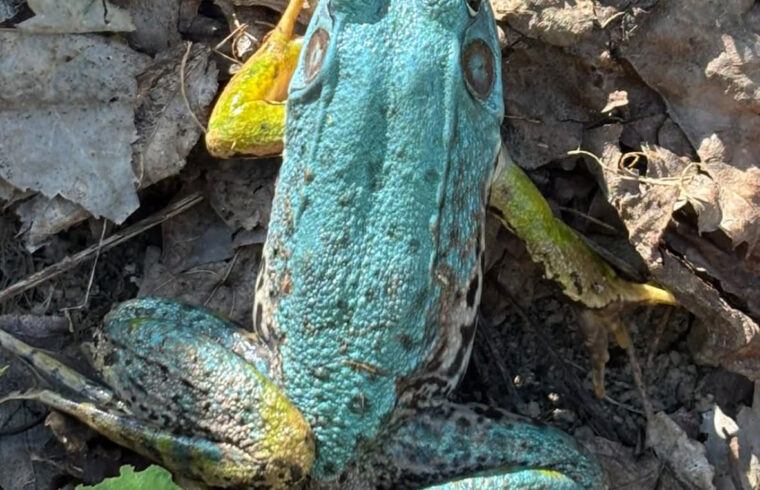By Thomas Smith
With the fire ban being lifted on Thursday, Aug. 28, the recent rain has been a blessing not only for humans, but nature around us.
On Friday, Aug. 15, Jennifer Semach of Walkabout Farm Therapeutic Riding noticed a visitor in their horse trough.
“It came over to the horse trough that I had over filled to get some moisture and relief from the heat,” said Semach. “Amphibians have really suffered this summer.”
The visitor was a blue-coloured green frog. This blue coloration, called axanthism, is caused by a mutation in the frog’s cells, reducing the amount of yellow pigmentation in their skin.
Stephen Hecnar, a biology professor at Lakehead University is currently researching frogs with axanthism. His project titled “Geographic Distribution of Axanthic Green Frogs” was started to collect the scattered records of axanthic green frogs to determine if there were any trends of occurrence across their geographic range. Their project currently consists of over 300 records from 200 different locations across Canada.
“Axanthism is very rare in Ontario and also across the entire geographic range of the Green Frog,” said Hecnar. “We found 6 out of 93,873 records of blue-coloured Green Frogs in the Ontario Reptile and Amphibian Atlas database.”
This suggests that blue green frogs are exceptionally rare, occurring at a rate of 0.006 per cent. In other records of the trait, axanthism occurs in less than one per cent of frogs found. Axanthism occurs in other species of frog species such as leopard frogs, bullfrogs, and eastern gray treefrogs. Green frogs seem to have this mutation more commonly than any other species.
Hecnar says that the data points to axanthism occurring more frequently in the northern part of the green frog’s range and that the trait increases in frequency heading eastward. The trait is also significantly more common in females.
Hecnar says that two large clusters of axanthism have been identified in Ontario. One is at the eastern end of Lake Ontario and the other is in the Bruce Peninsula. The other large cluster in Canada is on the border between New Brunswick and Nova Scotia.
The intense heat and mediocre snow coverage has been a great challenge to amphibians in Ontario.
Thin snow coverage in the past two years has reduced the amount of insulation that keeps frogs warm, increasing the over-winter mortality rate due to deeper freezing depth, says Hecnar. Late springs meant delayed emergence from their hibernation sites and reduced breeding season lengths.
“The increased heat and drought conditions will be affecting amphibians but some species appear to be more susceptible than others to these weather/climatic challenges,” said Dr. Hecnar. “We currently have limited knowledge of how climate change is affecting amphibians but interest is increasing and some research projects are working on the topic.”
Why might we have more blue green frogs in Haliburton County and in other parts of their northern range? That answer is currently unknown, says Hecnar.
The green frog’s colouration patterns help them blend in with their environment. As ambush predators, hiding from prey is crucial. With blue colouration, the frogs stand out more to predators. This may explain why there are more in the northern and furthest eastern range, because there are less predators, says Hecnar.
“Another hypothesis is that the darker bluish colouration may help individuals capture sunlight more efficiently,” said Hecnar. “Providing a thermal advantage for these cold-blood creatures in the colder part of their range.”
However, these hypotheses need to be tested in the future.
More information on the “Geographic Distribution of Axanthic Green Frogs” research project and the Amphibian and Reptile Ecology Lab can be found at shecnar.lakeheadu.ca.





 This axanthic blue coloured green frog was spottted in the horse trough at Walkabout Farm Therapeutic Riding Association. Stephen Hecnar, a biology professor at Lakehead University, estimates that the mutation occurs at a rate of 0.006 per cent /Submitted
This axanthic blue coloured green frog was spottted in the horse trough at Walkabout Farm Therapeutic Riding Association. Stephen Hecnar, a biology professor at Lakehead University, estimates that the mutation occurs at a rate of 0.006 per cent /Submitted 








